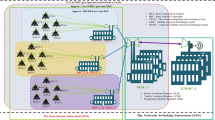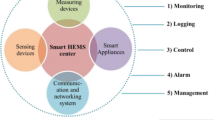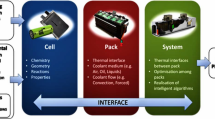Abstract
Energy efficiency in cellular networks is a growing concern for cellular operators with regard to maintaining profitability and reducing their overall environmental impact. Because evolved node Bs (eNBs) for long-term evolution wireless cellular networks are deployed to accommodate peak traffic, they are underutilized most of the time, especially under low-traffic conditions. Hence, switching eNBs on and off in accordance with traffic pattern variations is considered to be an effective method of improving energy efficiency in cellular networks. However, two main concerns of network operators when applying this technique are coverage issues and securing radio service for an entire area in response to the increased size of some cells to provide coverage for cell areas that are switched off. This study focuses on the parameters that affect coverage in order to find a balance between cellular network energy consumption and the area of cell coverage. To achieve this goal, particle swarm optimization, a bio-inspired computational method, has been adopted in this study to maximize the cell coverage area under the constraints of the transmission power of the eNB \((P_{tx})\), the total antenna gain (G), the bandwidth (BW), the signal-to-interference-plus-noise ratio (SINR), and shadow fading \((\sigma )\). In addition, the study investigated potential for gains in operational expenditures by operating eNB on solar energy. The optimum criteria, including economic, technical and environmental feasibility parameters, were analyzed using the HOMER.






















Similar content being viewed by others
References
Ericsson Corporation. (2013). Ericsson Corporation report. Ericsson Mobility Report on the Pulse of the Networked Society. Retrieved August 01, 2014 from http://www.ericsson.com/res/docs/2013/ericsson-mobility-report-june-2013.pdf.
Chen, T., Yang, Y., Zhang, H., Kim, H., & Horneman, K. (2011). Network energy saving technologies for green wireless access networks. IEEE Wireless Communications, 18(2), 30–38.
Suarez, L., Nuaymi, L., & Bonnin, J.-M. (2012). An overview and classification of research approaches in green wireless networks. EURASIP Journal on Wireless Communications and Networking, 2012(1), 1–18.
Alsharif, M., Nordin, R., & Ismail, M. (2014). Classification, recent advances and research challenges in energy efficient cellular networks. Wireless Personal Communications, 77(2), 1249–1269.
Oh, E., Krishnamachari, B., Liu, X., & Niu, Z. (2011). Toward dynamic energy-efficient operation of cellular network infrastructure. IEEE Communications Magazine, 49(6), 56–61.
Chiaraviglio, L., Ciullo, D., Meo, M., & Marsan, M. (2008). Energy-aware UMTS access networks. In Proceedings of 11th International Symposium on Wireless Personal Multimedia Communications (WPMC’08) (pp. 1–5).
Chiaraviglio, L., Ciullo, D., Meo, M., & Marsan, M. (2009). Energy-efficient management of UMTS access networks. In Proceedings of 21st International Teletraffic Congress (ITC 2009) (pp. 1–8), Paris, September 2009.
Marsan, M., Chiaraviglio, L., Ciullo, D., & Meo, M. (2009). Optimal energy savings in cellular access networks. In Proceedings of IEEE International Conference on Communications Workshops (ICC Workshops) (pp. 1–5), Germany, June 2009.
Zhou, S., Gong, J., Yang, Z., Niu, Z., & Yang, P. (2009). Green mobile access network with dynamic base station energy saving. In Proceedings of ACMMobiCom’09 (pp. 1–3), Beijing, China, September 2009.
Gong, J., Zhou, S., Niu, Z., & Yang, P. (2010). Traffic-aware base station sleeping in dense cellular networks. In Proceedings of 18th International Workshop on Quality of Service (IWQoS) (pp. 1–2), 2010.
Xiang, L., Pantisano, F., Verdone, R., Ge, X., & Chen, M. (2011). Adaptive traffic load-balancing for green cellular networks. In Proceedings of 22nd IEEE International Conference on Personal Indoor and Mobile Radio Communications (PIMRC) (pp. 41–45), Toronto, September 2011.
Lorincz, J., Capone, A., & Begusic, D. (2012). Impact of service rates and base station switching granularity on energy consumption of cellular networks. EURASIP Journal on Wireless Communications and Networking, 2012(1), 1–24.
Bousia, A., Antonopoulos, A., Alonso, L., Verikoukis, C. (2012). Green Distance-Aware Base Station Sleeping Algorithm in LTE-Advanced. In Proceedings of IEEE International Conference on Communications (ICC) (pp. 1347–1351), Ottawa, June 2012.
Niu, Z., Wu, Y., Gong, J., & Yang, Z. (2010). Cell zooming for cost-efficient green cellular networks. IEEE Communications Magazine, 48(11), 74–79.
Bhaumik, S., Narlikar, G., Chattopadhyay, S., & Kanugovi, S. (2010). Breathe to stay cool: adjusting cell sizes to reduce energy consumption. In Proceedings of ACM SIGCOMM workshop on Green networking (pp. 1–5).
Kokkinogenis, S., & Koutitas, G. (2012). Dynamic and static base station management schemes for cellular networks. In Proceedings of 2012 IEEE International Conference on Global Communications (GLOBECOM) (pp. 3443–3448).
Sthitaprajna Rath, S. M., Ali, Md, & Iqbal, N. (2012). Strategic approach of hybrid solar-wind power for remote telecommunication sites in India. International Journal of Scientific & Engineering Research, 3(6), 1–6.
Pragya, N., Nema, R. K., & Saroj, R. (2010). Minimization of green house gases emission by using hybrid energy system for telephony base station site application. Renewable and Sustainable Energy Reviews, 14, 1635–1639.
Ani, V. A., & Emetu, A. N. (2013). Simulation and optimization of hybrid diesel power generation system for GSM base station site in Nigeria. Electronic Journal of Energy & Environment, 1(1), 1–20.
Martínez-Díaz, M., Villafáfila-Robles, R., & Montesinos-Miracle. D. (2013). Study of optimization design criteria for stand-alone hybrid renewable power systems. In Proceedings of International Conference on Renewable Energies and Power Quality (ICREPQ’13) (pp. 20–22), Bilbao, Spain.
Subodh, P., Madhu, S. D., Muna, A., & Jagan, N. S. (2013). Technical and economic assessment of renewable energy sources for telecom application: a case study of Nepal telecom. In Proceedings of 5th International Conference on Power and Energy Systems (pp. 28–30) Kathmandu, Nepal.
Kanzumba, K., & Herman, J. V. (2013). Hybrid renewable power systems for mobile telephony base stations in developing countries. Renewable Energy, 51(2013), 419–425.
Prabodh, B., Prakshan, N. P., Kishore, N. K. (2009). Renewable hybrid stand-alone telecom power system modeling and analysis. In Proceedings of TENCON 2009, Singapore (pp. 1–6).
Vincent, A., & Anthony, N. (2013). Potentials of optimized hybrid system in powering off-grid macro base transmitter station site. International Journal of Renewable Energy Research, 3(4), 1–11.
Auer, G., Blume, O., Giannini, V., Godor, I., Imran, A. M., Jading, Y., et al. (2010). Energy efficiency analysis of the reference systems, areas of improvements and target breakdown. EARTH Project Report, Deliverable, D2(3), 1–68.
Johansson, K., Furuskar, A., Karlsson, P., Zander, J. (2004). Relation between base station characteristics and cost structure in cellular systems. In Proceedings of 15th IEEE International Symposium on Personal, Indoor and Mobile Radio Communications (PIMRC 2004) (pp. 2627–2631).
Debus, W. (2006). RF path loss & transmission distance calculations. New York: Axonn, LLC.
Sesia, S., Toufik, I., & Baker, M. (2011). LTE - The UMTS long term evolution: From theory to practice (2nd ed.). New York: Wiley.
Goldsmith, A. (2005). Wireless Communication (2nd ed.). Cambridge: Cambridge University Press.
Kennedy, J., & Eberhart, R. (1995). Particle swarm optimization. In Proceedings of IEEE International Conference on Neural Networks (pp. 1942–1948).
Mekhilefa, S., Safaria, A., Mustaffaa, W. E. S., Saidurb, R., Omara, R., & Younisc, M. A. A. (2012). Solar energy in Malaysia: Current state and prospects. Renewable and Sustainable Energy Reviews, 16(1), 386–396.
Borhanazada, H., Mekhilefa, S., Saidurb, R., & Boroumandjazib, G. (2013). Potential application of renewable energy for rural electrification in Malaysia. Renewable Energy, 59(2013), 210–219.
Sopian, K., Hj, M. Y., & Othman, A. W. (1995). The wind energy potential of Malaysia. Renewable Energy, 6(8), 1005–1016.
Borhanazada, H., Mekhilefa, S., Saidurb, R., & Ganapathy, V. G. (2014). Long-term wind speed forecasting and general pattern recognition using neural networks. IEEE Transactions on Sustainable Energy, 5(2), 546–553.
Azhari, A. W., Sopian, K., Zaharim, A., & Al ghoul, M. (2008). A new approach for predicting solar radiation in tropical environment using satellite images e case study of Malaysia. WSEAS Transactions on Environment and Development, 4(4), 2008.
Khatib, T., Mohamed, A., Sopian, K., & Mahmoud, M. (2012). Solar energy prediction for Malaysia using artificial neural networks. International Journal of Photoenergy, 2012, 1–16.
Gunter, S. (2009). The green base station. In Proceedings of 4th International Conference on Telecommunication - Energy Special Conference (TELESCON) (pp. 1–6).
Rehman, S., & Al-Hadhrami, L. M. (2010). Study of a solar PVedieselebattery hybrid power system for a remotely located population near Rafha, Saudi Arabia. Energy, 35(12), 4986–4995.
Lambert, T., Gilman, P., & Lilienthal, P. (2014). Micropower System Modeling with HOMER (2006). Retrieved August 01, 2014 from http://homerenergy.com/documents/MicropowerSystemModelingWithHOMER.pdf.
Malaysian Energy Corporation. (2014). Retrieved August 01, 2014 from http://www.tnb.com.my/business/for-industrial/pricing-tariff.html.
Acknowledgments
The authors would like to thank the Universiti Kebangsaan Malaysia for the financial support of this work, under the Grant Ref: ETP-2013-072.
Author information
Authors and Affiliations
Corresponding author
Rights and permissions
About this article
Cite this article
Alsharif, M.H., Nordin, R. & Ismail, M. Intelligent cooperation management among solar powered base stations towards a green cellular network in a country with an equatorial climate. Telecommun Syst 62, 179–198 (2016). https://doi.org/10.1007/s11235-015-0073-y
Published:
Issue Date:
DOI: https://doi.org/10.1007/s11235-015-0073-y




